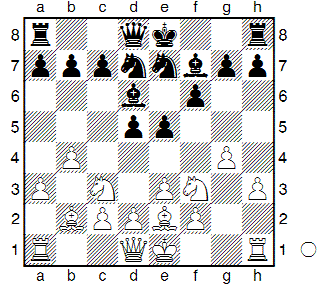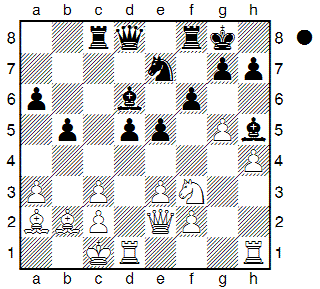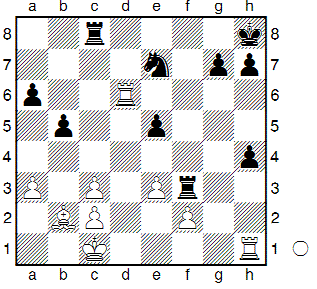Monkey Business Does Not Phase Ken!
There has been some discussion about publishing games by members of the club on this web site, and a couple of players have come forward and offered games for scrutiny. First up is Ken Cairney with a nice win (playing black) for the third team. However, chess games are a bit like time travel in that, every game – and in particular every nice win – has its alternate futures!
Let’s take a look at Ken’s game. Ken himself has supplied the main notes, but I’ll chip in too (in italics).
1.b4
The Sokolsky Opening (also known as the Orangutan or Polish Opening).
1…e5
My opponent has elected a flank opening, surely claiming space in the centre must be reasonable
2.a3 (? – Mark) d5

The Orangutan Opening (as Ken points out), but why do people play such things? According to classical thinking, White has the first move and should seek an advantage, while black should have to seek to equalise. Here, after only two moves, I’d say black has a clear superiority! Further, if there is any sense to be made of white’s first move, his second move ruled it out.
3.Bb2
He threatens e5, now if I defend with Nc6 my c-pawn is blocked and may give him tempo with the b5 advance, Bd6 blocks defence of d5 so…
3…f6 4.e3 Bd6
This seems to be the only square for this bishop and it leaves e7 for a knight.
5.Nf3 Bg4
I don’t have a plan yet, I suspect my opponent doesn’t have one either.
I disagree! I think black is pursuing an excellent plan – one of gaining a strong centre and keeping it intact. I think Ken’s problem is in failing to realise that this is a legitimate plan, and an excellent one at that. Ken is right however, about white not having a plan. The point is black is stearing his army into a harmonious formation, and white isn’t.
The f7f6 weakened the white squares around my king so this bishop has a role to play on the K-side.
6.Be2 Ne7 7.h3 Bh5 8.Nc3 Nd7 9.g4 Bf7

My Q-side bishop has found a nice home, he observes the centre and defends the king.
I think Ken’s opening play has been excellent. Compare white’s and black’s positions! I particularly like the way Ken has settled for his knights being on d7 and e7 – thus not giving white’s advanced flank pawns any targets.
10.Bb5
Ok, give me the two bishops. White should be worrying about where to put his king
Regarding allowing the exchange and black getting the two bishops: I think there is a bit more to it than that. However, I’m going to let it pass for now (in the interest of getting this article finished) and perhaps come back to discussing the pros and cons another time. At any rate, if white does exchange it’s hard to see how it hurts black because …c7-c5 can be prepared by (say) …b7-b6.
10…0-0 11.Qe2
Was his previous move solely to free a square for his queen? Considering what happens next d3 and Qd2 might have been a better plan.
11…a6 I want to play c5 but the intruder bishop needs to make his intentions known
12.Ba4 b5 13.Bb3
At this point I considered N-d7-b6=c4 but decided on the more direct c5
13…Rc8 ?! (- Mark)
Not necessary. I think black should play 13…c5 immediately.
14.h4
Is white planning K-side action? The classic reply to a flank advance is an assault in the centre, so it’s time for the c5 break!
14…c5 15.bxc5 Nxc5 16.Ba2
This makes black’s 13th move look like a good one, but it didn’t have to be this way. White does not need to preserve this bishop. Black should not exchange on b3 because this gives up the knight on c5 – an active piece – for one that isn’t doing very much, and also it lets white get rid of the target pawn on c2. This is another point that could be discussed further, but I want to move on (again I’m copping out and saying perhaps I’ll come back to this another time).
16…Ne4 17.g5 Nxc3
By removing an attacker of d5 I free the bishop on f2 for a more aggressive role
18.dxc3
That was kind of him, blocking one bishop and giving me c4 but the Knight on f3 is a target!
18…Bh5 19.0-0-0

19…fxg5 ? (-Mark. 19…e4 looks simplest, winning the house). 20.Bxd5+ Kh8
Oh dear, my first blunder, why not Nxd5 and the game is over [20…Nxd5 21.Rxd5 Bxf3 22.Qd2 Bxd5 23.Qxd5+ Kh8]
21.Qd2 ?? (- Mark. Surely 21. Rh3 has to be tried, in order to keep material loss to a minimum whilest keeping some activity in the white position)
21…Bxf3 22.Bxf3 Rxf3 23.Qxd6 Qxd6 24.Rxd6
Now gh, he can’t play Rxh because Nf4, so I have a passed a-pawn soon to be supported by Ng6, then Rxf2 and pawn to h2
Actually, although black is a bit better, it’s nowhere near as good as it could have been.

24…gxh4 25.Rxh4??
A terrible blunder. White could have played 25.Rh2 when black is practically forced to play 25…Rcf8 to gang up on white’s f2 pawn. Black is still much better but white has ideas for ways to make a nuisance of himself. For example, white has plans involving taking black’s a6 pawn and sacraficing his c3 pawn to clear the way for the bishop to e5 and ultimately g7 (note white can – after an exchange of rooks on f2 – check on the back rank to deflect the knight before putting his rook on the seventh rank to attack g7). None of this is concrete but, as I say, white should look for ways to be a nuisance.
25…Nf5 26.Rxh7+ Kxh7 27.Rxa6 Rxf2 28.e4 Rd8 29.Ba1 Ne3 30.c4 Rxc2+ 31.Kb1 Rd1# 0-1